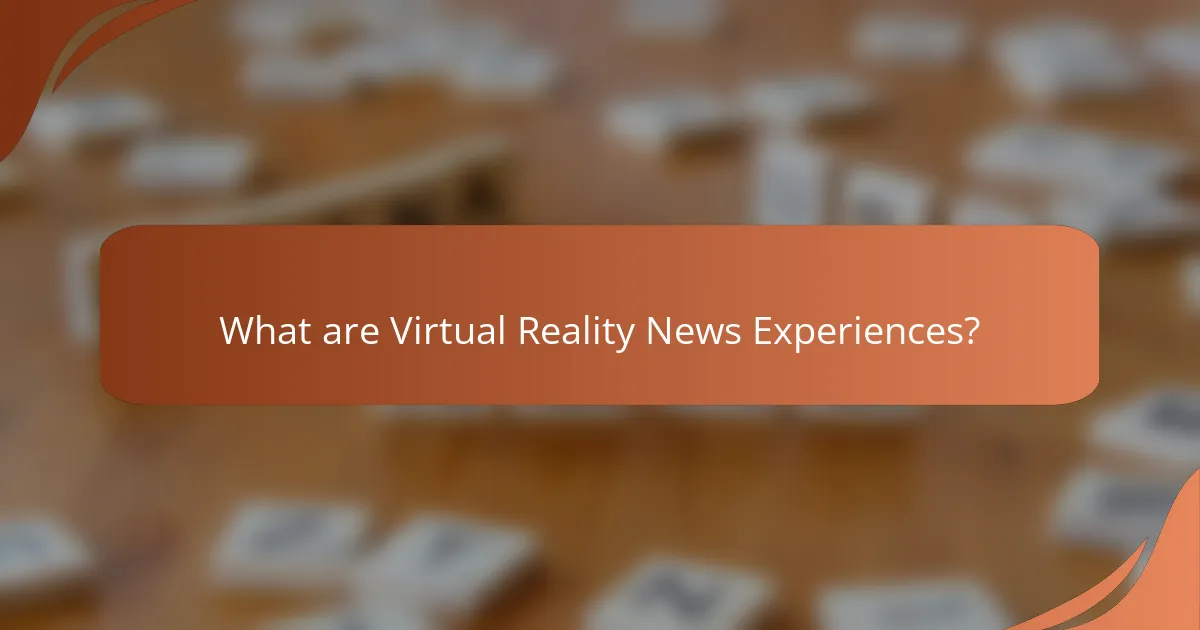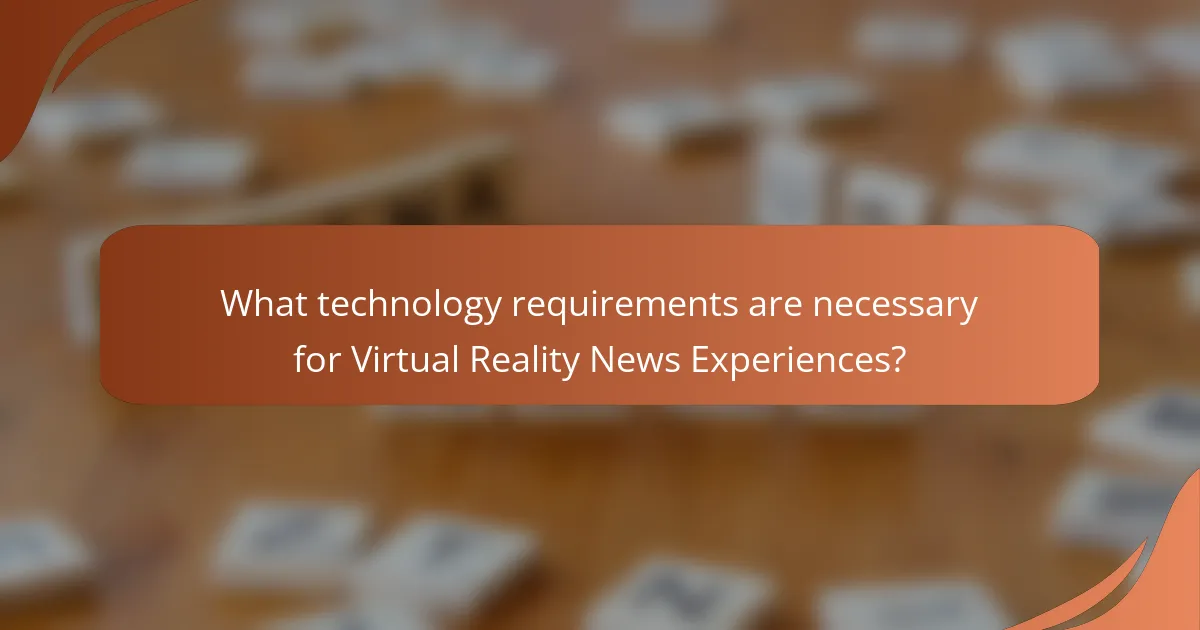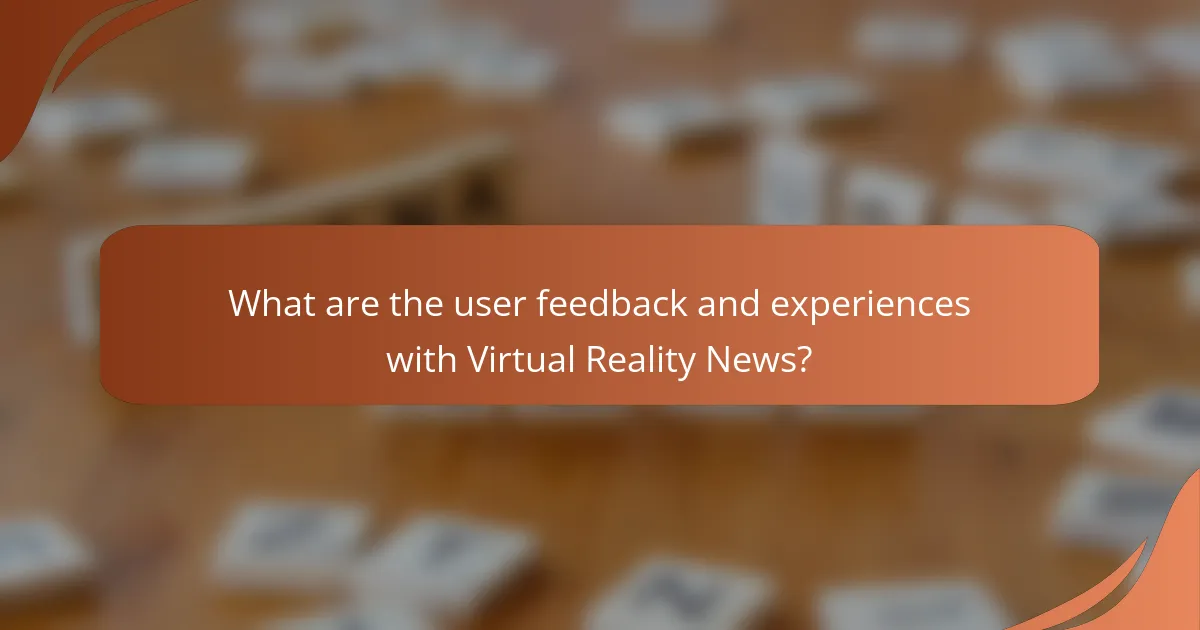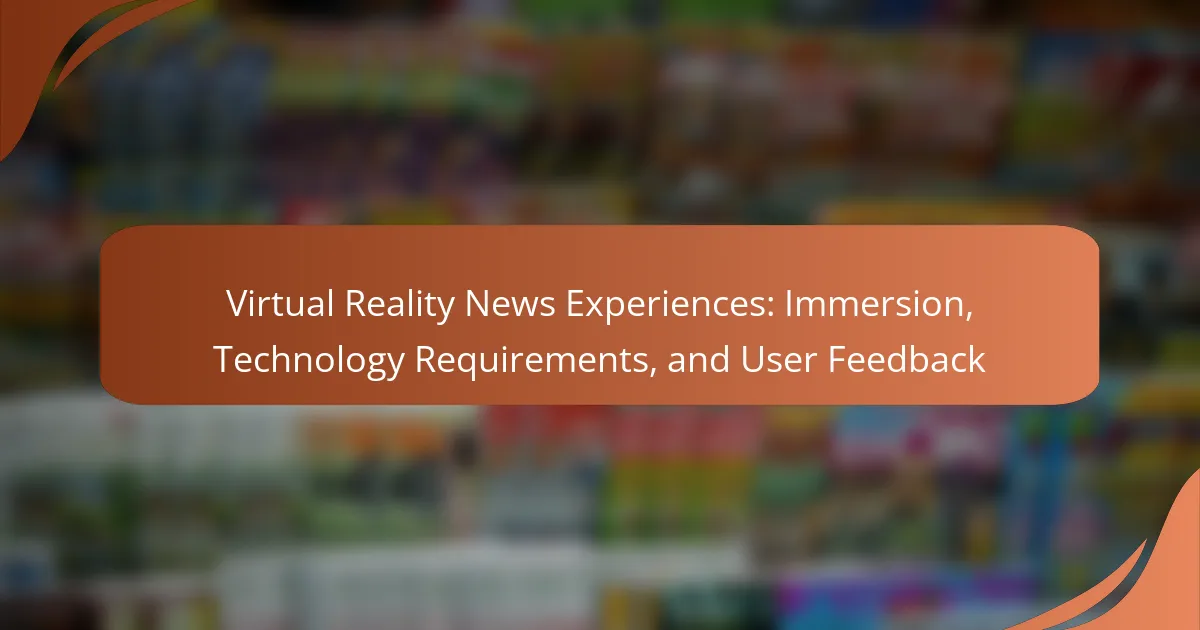Virtual Reality News Experiences utilize virtual reality technology to deliver immersive news presentations in a 3D environment. This innovative format enhances user engagement by allowing individuals to explore news stories from multiple perspectives, integrating multimedia elements such as video, audio, and graphics. Research shows that these immersive experiences can improve information retention and foster empathy regarding complex issues. However, effective Virtual Reality News Experiences require specific technology, including high-performance computers, VR headsets, and motion tracking systems. User feedback is predominantly positive, highlighting the unique sense of presence and interactive elements, though some concerns about technology requirements and potential motion sickness have been noted.

What are Virtual Reality News Experiences?
Virtual Reality News Experiences are immersive news presentations delivered through virtual reality technology. They allow users to engage with news stories in a 3D environment. This format enhances user engagement and provides a sense of presence. Users can explore news events from various perspectives. The experiences often integrate multimedia elements like video, audio, and graphics. Research indicates that immersive experiences can improve information retention. According to a study by the Stanford Graduate School of Education, VR can increase empathy and understanding of complex issues. Virtual Reality News Experiences are increasingly adopted by news organizations to innovate storytelling.
How do Virtual Reality News Experiences differ from traditional news formats?
Virtual Reality News Experiences provide immersive engagement that traditional news formats cannot offer. In VR, users can explore news environments and interact with content in a three-dimensional space. This level of immersion enhances emotional connection and understanding of news stories. Traditional news formats, such as print or video, present information in a linear manner. Users passively consume content without spatial interaction. Research indicates that immersive experiences can lead to higher retention rates of information. A study by the University of Southern California found that participants in VR environments reported feeling more present and engaged with the news. This engagement can result in a deeper understanding of complex issues compared to traditional formats.
What immersive elements are unique to Virtual Reality News Experiences?
Virtual Reality News Experiences feature several unique immersive elements. These include 360-degree video, which allows users to explore a scene from all angles. Spatial audio enhances realism by providing sound that corresponds to the user’s location. Interactive storytelling enables users to engage with content actively. Real-time data integration presents live updates within the immersive environment. Customizable avatars allow users to represent themselves in the virtual space. These elements create a sense of presence and engagement that traditional news formats cannot achieve.
How do user interactions enhance the experience of Virtual Reality news?
User interactions enhance the experience of Virtual Reality news by increasing engagement and personalization. When users interact with VR news content, they can choose their viewing angles and explore different aspects of a story. This active participation makes the news experience more immersive. Research shows that immersive environments improve information retention. A study published in the journal “Computers in Human Behavior” found that users who engaged with interactive VR content retained 70% more information than those who consumed traditional media. Additionally, user feedback can shape future VR news experiences, allowing for tailored content that meets audience preferences. Overall, user interactions create a more dynamic and impactful way to consume news.
Why is immersion important in Virtual Reality News Experiences?
Immersion is crucial in Virtual Reality News Experiences because it enhances user engagement and emotional connection. When users feel immersed, they are more likely to pay attention to the content. This heightened focus can lead to better retention of information. Studies show that immersive experiences can increase empathy towards subjects presented in news. For example, a study by the University of Southern California found that VR can significantly enhance emotional responses to news stories. Immersion transforms passive viewing into an active experience, making the news more impactful. Therefore, immersion is a key factor in delivering effective and memorable news experiences in virtual reality.
What psychological effects does immersion have on the audience?
Immersion in virtual reality experiences significantly impacts the audience’s psychological state. It enhances emotional engagement, leading to increased empathy towards the content presented. Studies show that immersive environments can heighten feelings of presence, making users feel as though they are part of the narrative. This sense of presence can lead to stronger emotional responses compared to traditional media. Research indicates that immersion can also affect memory retention, with users recalling details more vividly after experiencing immersive content. Furthermore, immersive experiences can create a sense of escapism, allowing users to temporarily disengage from reality. This psychological effect can be beneficial in reducing stress and anxiety levels. Overall, immersion in virtual reality news experiences shapes audience perceptions and emotional responses in profound ways.
How does immersion influence information retention in news consumption?
Immersion significantly enhances information retention in news consumption. Immersive experiences engage users more deeply than traditional formats. This heightened engagement helps individuals process and remember information more effectively. Research indicates that immersive environments can lead to a 30% increase in recall compared to non-immersive formats. For example, a study by Bailenson et al. (2008) demonstrated that participants who experienced news in virtual reality retained more facts than those who viewed standard video. This suggests that immersion not only captures attention but also facilitates better cognitive processing of the news content.

What technology requirements are necessary for Virtual Reality News Experiences?
Virtual Reality News Experiences require specific technology to function effectively. Essential components include a high-performance computer or gaming console to run VR software. VR headsets such as Oculus Rift or HTC Vive are necessary for immersive viewing. Motion tracking systems enhance user interaction within the virtual environment. Additionally, 3D audio technology is crucial for realistic soundscapes. High-speed internet is required for streaming content without lag. Software platforms like Unity or Unreal Engine facilitate the creation of VR news content. These technology requirements ensure a seamless and engaging user experience in virtual reality news.
What hardware is essential for accessing Virtual Reality news?
Essential hardware for accessing Virtual Reality news includes a VR headset, a compatible computer or gaming console, and motion controllers. The VR headset provides the immersive visual experience necessary for engaging with VR content. Popular models include the Oculus Quest 2 and HTC Vive. A powerful computer or gaming console, such as a gaming PC with high-end graphics capabilities or a PlayStation 5, is required to run VR applications smoothly. Motion controllers enhance interactivity by allowing users to navigate and interact within the virtual environment. These components collectively ensure a seamless and engaging VR news experience.
What are the minimum specifications for VR headsets and computers?
The minimum specifications for VR headsets typically include a resolution of 1080×1200 pixels. A refresh rate of at least 90 Hz is also required for smooth visuals. The field of view should be around 100 degrees for immersive experiences. For computers, a minimum GPU like NVIDIA GTX 1060 or AMD Radeon RX 480 is necessary. The CPU should be at least an Intel i5-4590 or AMD Ryzen 5 1500X. Additionally, 8 GB of RAM is the standard minimum requirement. These specifications ensure adequate performance for a satisfactory VR experience.
How do different VR platforms affect the news experience?
Different VR platforms significantly affect the news experience by influencing immersion, interactivity, and accessibility. Platforms like Oculus Rift provide high-resolution visuals, enhancing user engagement with news content. In contrast, mobile VR platforms like Google Cardboard offer a more accessible but less immersive experience. The level of interactivity varies; platforms with motion tracking allow users to explore news environments, fostering a deeper understanding of events. Research shows that immersive experiences can increase empathy towards news stories, as evidenced by a study from the University of Southern California. This study found that users reported heightened emotional responses when consuming news in VR compared to traditional media. Thus, the choice of VR platform directly shapes how users perceive and interact with news content.
What software is needed to create and view Virtual Reality News Experiences?
To create and view Virtual Reality News Experiences, software such as Unity or Unreal Engine is essential. These platforms enable developers to build immersive VR environments. Additionally, VR-specific tools like A-Frame and Amazon Sumerian can be utilized. For viewing, VR headsets require compatible software, often provided by the headset manufacturer. Popular VR headsets include Oculus Rift and HTC Vive, which have their own software ecosystems. This software supports various formats and enhances user engagement through interactive elements.
Which content creation tools are popular among VR news developers?
Popular content creation tools among VR news developers include Unity, Unreal Engine, and A-Frame. Unity is widely used for its versatility and extensive asset store. Unreal Engine offers high-fidelity graphics, making it suitable for immersive experiences. A-Frame is favored for web-based VR applications due to its simplicity. These tools enable developers to create engaging and interactive news content. The use of these platforms supports the development of rich, immersive environments that enhance user engagement in virtual reality news experiences.
How do software updates impact the functionality of Virtual Reality news applications?
Software updates enhance the functionality of Virtual Reality news applications by improving performance and adding new features. These updates often fix bugs that may hinder user experience. They can also optimize graphics and processing speeds, leading to smoother interactions. Additionally, updates may introduce new content or functionalities, such as enhanced user interfaces or additional immersive elements. According to a study by the International Journal of Human-Computer Interaction, software updates significantly increase user satisfaction and engagement in VR applications. Regular updates ensure compatibility with evolving hardware and software standards, maintaining the application’s relevance in a rapidly advancing field.

What are the user feedback and experiences with Virtual Reality News?
User feedback on Virtual Reality News is generally positive, highlighting enhanced immersion. Many users report a feeling of presence that traditional news formats cannot provide. They appreciate interactive elements, which allow for deeper engagement with the content. Users often mention the ability to explore news stories from different perspectives. This format fosters a more comprehensive understanding of complex issues. However, some users express concerns about technology requirements. High-performance hardware is often necessary for optimal experiences. Additionally, a few users report motion sickness as a drawback. Overall, the feedback indicates that Virtual Reality News offers a unique and engaging way to consume information.
How do users perceive the quality of Virtual Reality News Experiences?
Users perceive the quality of Virtual Reality News Experiences as highly immersive and engaging. Many users report a sense of presence in the news stories they experience. This immersion can enhance emotional connection to the content. Studies indicate that users find VR news more impactful than traditional media. For instance, a 2020 study by the Pew Research Center found that 70% of participants felt more informed after experiencing news in VR. Additionally, users appreciate the interactive elements that VR provides. However, some users express concerns about technical issues, such as motion sickness or hardware limitations. Overall, user feedback highlights both the strengths and challenges of VR in news delivery.
What common themes emerge from user reviews and feedback?
Common themes from user reviews and feedback on virtual reality news experiences include immersion, ease of use, and technology requirements. Users frequently mention the immersive quality of VR, stating it enhances their engagement with news content. Many reviews highlight the ease of navigation within the VR environment, indicating a positive user experience. However, some users express concerns about the technology requirements, noting high hardware specifications can be a barrier. Additionally, feedback often points to the novelty of VR as a compelling aspect, but some users feel it can be overwhelming at times. Overall, these themes reflect a mix of enthusiasm and challenges associated with adopting VR for news consumption.
How does user feedback influence the development of future VR news content?
User feedback significantly influences the development of future VR news content. It provides insights into user preferences and experiences. This feedback helps creators understand what aspects of the content are engaging or confusing. By analyzing user comments and ratings, developers can identify areas for improvement. For instance, if users report discomfort during VR experiences, developers may adjust the design to enhance comfort. Additionally, user feedback can shape storytelling techniques and interactive elements in VR news. Research indicates that 70% of users prefer content that aligns with their interests, showcasing the importance of tailored experiences. As a result, feedback directly informs content creation strategies, ensuring relevance and user satisfaction.
What challenges do users face when engaging with Virtual Reality News Experiences?
Users face several challenges when engaging with Virtual Reality News Experiences. One major challenge is the requirement for specialized hardware. Many users lack access to high-performance VR headsets and computers. This limits the audience and can lead to a fragmented experience. Another challenge is the potential for motion sickness. Studies indicate that up to 40% of users experience discomfort during VR sessions. User interface complexity also poses a barrier. Navigating VR environments can be unintuitive for new users. Additionally, content availability is an issue. There is a limited range of quality VR news content currently offered. Lastly, user engagement can vary significantly. Some users may find it difficult to immerse themselves fully in the experience. These challenges collectively hinder the widespread adoption of VR news experiences.
What technical issues are frequently reported by users?
Users frequently report issues such as low frame rates and lag in virtual reality experiences. These technical problems can significantly hinder immersion. Additionally, users often encounter tracking errors, where the system fails to accurately follow head and hand movements. Connection problems, including latency and disconnection from servers, are also common complaints. Many users experience compatibility issues with hardware and software. Another frequent issue is discomfort or motion sickness due to poor optimization. Lastly, users report difficulties with setup and installation processes. These issues collectively impact user satisfaction and overall experience in virtual reality environments.
How do usability concerns affect user satisfaction with VR news?
Usability concerns significantly impact user satisfaction with VR news. When users encounter difficulties in navigation or interaction, their overall experience diminishes. High usability ensures that users can easily access content without frustration. Poor usability can lead to feelings of disorientation or confusion. Studies show that 70% of users abandon VR experiences due to usability issues. Furthermore, seamless interactions enhance immersion, which is crucial in VR environments. If users struggle with controls, they are less likely to engage with the news content. Ultimately, addressing usability concerns can lead to higher user satisfaction and increased retention rates.
What best practices can enhance the user experience in Virtual Reality News?
Best practices to enhance user experience in Virtual Reality News include optimizing navigation, ensuring content interactivity, and maintaining high-quality visuals. Navigation should be intuitive, allowing users to easily explore different news stories. Interactive elements, such as clickable graphics or embedded videos, can engage users more effectively. High-quality visuals are crucial; research shows that 90% of information transmitted to the brain is visual. Additionally, providing clear audio enhances comprehension and immersion. User feedback should be actively sought to continually improve experiences. Implementing these practices leads to more engaging and informative VR news environments.
How can news organizations improve accessibility in VR news experiences?
News organizations can improve accessibility in VR news experiences by incorporating features like subtitles and audio descriptions. Subtitles provide text for spoken content, aiding those with hearing impairments. Audio descriptions narrate visual elements, assisting visually impaired users.
Additionally, offering customizable settings can enhance user comfort. This includes adjustable text size, color contrast, and user interface modifications. Implementing user feedback mechanisms allows organizations to identify and address accessibility issues directly.
Research shows that inclusive design increases audience engagement. A study by the International Journal of Human-Computer Interaction found that accessible VR content significantly boosts user satisfaction. This approach not only broadens audience reach but also fosters a more inclusive media environment.
What strategies can be implemented to engage users more effectively in VR news?
Incorporating interactive storytelling can engage users more effectively in VR news. This allows users to make choices that influence the narrative. Utilizing 360-degree video enhances immersion by providing a sense of presence in the news environment. Real-time data integration can offer users updated information relevant to their interests. Personalized content recommendations based on user preferences can increase engagement. Additionally, social sharing features encourage users to discuss and share their experiences. Gamification elements can motivate users to explore news stories more deeply. Finally, gathering user feedback can help refine VR news experiences, ensuring they meet audience needs.
Virtual Reality News Experiences are immersive news presentations that leverage virtual reality technology to enhance user engagement and understanding of news stories. This article explores the unique attributes of VR news, including its 360-degree video, spatial audio, and interactive storytelling elements, which differentiate it from traditional news formats. It also examines the technology requirements for accessing VR news, user feedback on the experiences, and the psychological effects of immersion on information retention and empathy. Key challenges such as hardware limitations and usability concerns are addressed, along with best practices for improving user experience and accessibility in VR news content.
